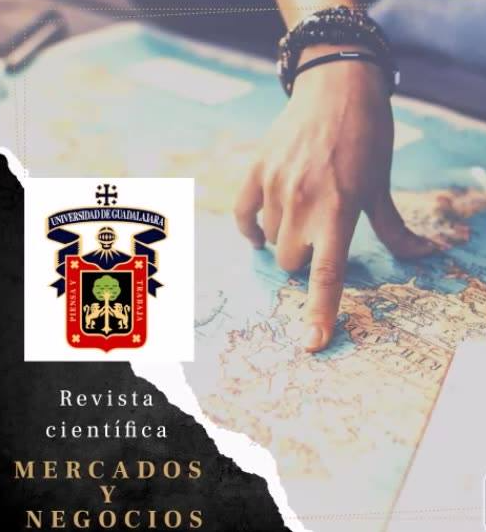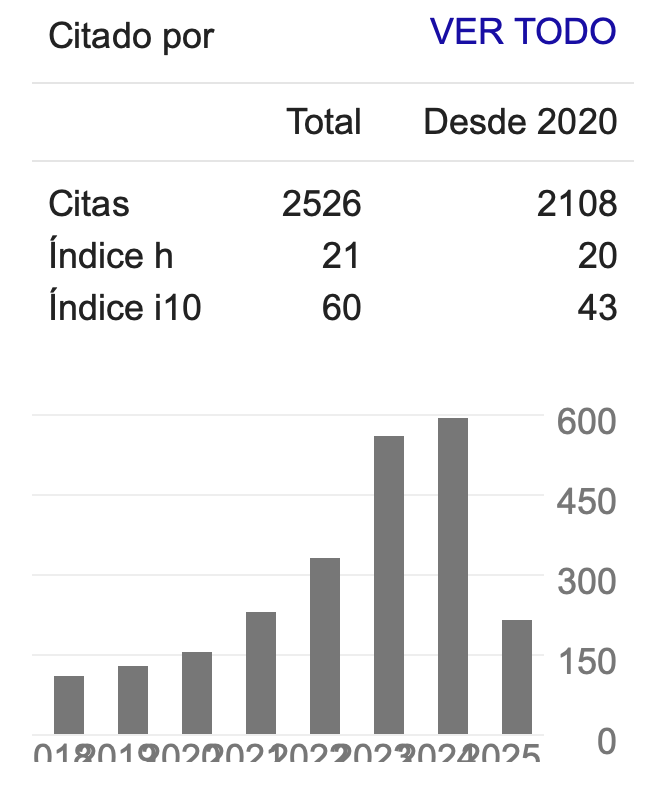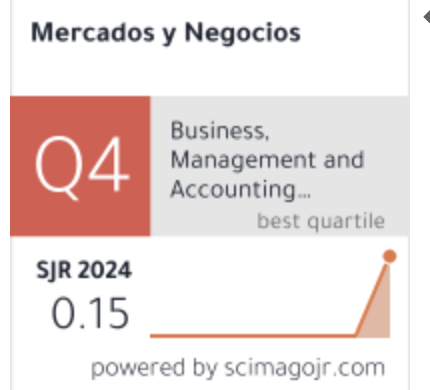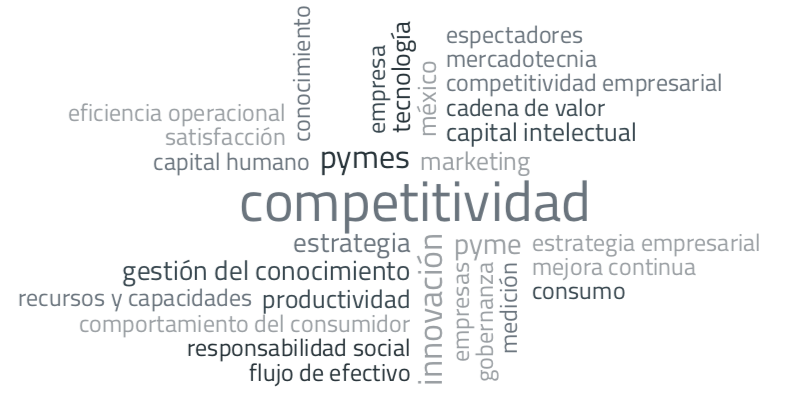Determinants of Receptivity Towards Entomophagy among Young Adults
DOI:
https://doi.org/10.32870/myn.vi53.7747Palabras clave:
Entomofagia, Alimentos sustenibles, Alimentos alternativosResumen
This research focuses on understanding the factors influencing the acceptance of entomophagy in Morelia, Michoacán. The study involves a survey aimed at two distinct groups of young adults aged 18 to 29 (control and experimental), a demographic known for being open to evolving food preferences. The results revealed interesting differences in preferences between individuals who have and have not tried insect-based foods. Surprisingly, the price did not emerge as a dominant influencing factor. The study suggests entomophagy can be a viable and accepted dietary option when relevant information is easily accessible, potentially reducing neophobia levels.Citas
Acosta, A. (2024). Green Consumer’s Paradox. Mercados y Negocios, (51), 53–76. https://doi.org/10.32870/myn.vi51.7714
Alfaro, F. (2023). Ha bajado 10% disponibilidad de agua en Morelia por temporada de estiaje Quadratín. Publicado el 23 de mayo de 2023.
Aung, M., Dürr, J., Borgemeister, C., & Börner, J. (2023). Factors affecting consumption of edible insects as food: entomophagy in Myanmar. Journal of Insects as Food and Feed, 9(6), 721-739. https://doi.org/10.3920/JIFF2022.0151
Badgley, C., Moghtader, J., Quintero, E., Zakem, E., Chappell, M. J., Avilés-Vázquez, K., Perfecto, I. (2007). Organic agriculture and the global food supply. Renewable Agriculture and Food Systems, 22(2), 86–108. https://doi:10.1017/s1742170507001640
Borsari, B. (2022). Entomophagy and the Nexus Between Human and Planetary Health. In: Leal Filho, W. (Eds) Handbook of Human and Planetary Health. Climate Change Management. Springer, Cham. https://doi.org/10.1007/978-3-031-09879-6_3
Bialkova, S., Sasse, L. Fenko A. (2016). The role of nutrition labels and advertising claims in altering consumers' evaluation and choice, Appetite, 96, 38-46. https://doi.org/10.1016/j.appet.2015.08.030.
Banu, A. N., & Kudesia, N. (2023). Prospects of entomophagy as a nutrition-rich reservoir. Journal of Entomological Research, 47(4), 835-838. https://doi.org10.5958/0974-4576.2023.00154.8
Camacho, P. F. G. (2022). Hacia una ciudad de Morelia sensible al agua. Tesis Facultad de Ingeniería Civil de la UMSNH.
Caparros Megido, R., Sablon, L., Geuens, M., Brostaux, Y., Alabi, T., Blecker, C., ... Francis, F. (2014). Edible insects acceptance by B Belgian consumers: promising attitude for entomophagy development. Journal of Sensory Studies, 29(1), 14-20. https://doi.org/10.1111/joss.12077
Carvalho, F. P. (2006). Agriculture, pesticides, food security, and food safety. Environmental Science Policy, 9(7-8), 685–692. http://doi:10.1016/j.envsci.2006.08.002
Cerritos, R. (2019). Revalorando el uso de insectos para consumo humano. UNAM.
Cervera, B., Serrano, U., Daouas, T., Delicado, S. & García M. (2014). Hábitos alimentarios y evaluación nutricional en una población universitaria tunecina. Nutrición Hospitalaria, 30(6), 1350-1358. https://dx.doi.org/10.3305/nh.2014.30.6.7954
Chantawannakul, P. (2020). From entomophagy to entomotherapy. Frontiers in Bioscience-Landmark. (Landmark Ed) 2020, 25(1), 179–200. https://doi.org/10.2741/4802
Cicatiello, C., Vitali, A., & Lacetera, N. (2020). How does it taste? Appreciation of insect-based snacks and its determinants. International Journal of Gastronomy and Food Science, 21, 100211. https://doi.org/10.1016/j.ijgfs.2020.100211
Cronin, J., Anandarajah, G., & Dessens, O. (2018). Climate change impacts on the energy system: a review of trends and gaps. Climatic Change. https://doi:10.1007/s10584-018-2265-4
Cruces, L., de la Peña, E. & De Clercq, P. (2020). Insect diversity associated with quinoa (Chenopodium quinoa Willd.) in three altitudinal production zones of Peru. International Journal Tropical Insects Science 40, 955–968. https://doi.org/10.1007/s42690-020-00154-3
Cruz, P., & Peniche, C. (2018). La domesticación y crianza de insectos comestibles: una línea de investigación poco explorada y con gran potencial para el desarrollo sostenible y la seguridad alimentaria en México. Folia Entomológica Mexicana (nueva serie), 4(2), 66-79.
Dagevos, H. (2021). A literature review of consumer research on edible insects: recent evidence and new vistas from 2019 studies. Journal of Insects as Food and Feed, 7(3), 249-259. https://doi.org/10.3920/JIFF2020.0052
Dagevos, H., & Taufik D. (2022). Eating full circle: Exploring consumers’ sympathy for circularity in entomophagy acceptance. Food Quality and Preference, 105 (104760), https://doi.org/10.1016/j.foodqual.2022.104760
Derler, H., Lienhard, A., Berner, S., Grasser, M., Posch, A., & Rehorska, R. (2021). Use Them for What They Are Good at Mealworms in Circular Food Systems. Insects, 12(1), 40. https://doi.org/10.3390/insects12010040
Devi, W. D., Bonysana, R., Singh, K. D., Koijam, A. S., Mukherjee, P. K., & Rajashekar, Y. (2024). Bio-economic potential of ethno-entomophagy and its therapeutics in India. npj Science of Food, 8(1), 15. https://doi.org/10.1038/s41538-024-00260-3
Doğan, E., & Çekal, N. (2022). Sustainable Food Alternative in Gastronomy: Edible Insects (Entomophagy). International Journal of Agriculture Environment and Food Sciences, 6(2), 246-253. https://doi.org/10.31015/jaefs.2022.2.7
Feng, Y., Chen, X., Zhao, M., He, Z., Sun, L., Wang, C. & Ding, W. (2018). Edible insects in China: Utilization and prospects. Insect Science, 25, 184-198. https://doi.org/10.1111/1744-7917.12449
Francis, F., Doyen, V., Debaugnies, F., Mazzucchelli, G., Caparros, R., Alabi, T., & Corazza, F. (2019). Limited cross reactivity among arginine kinase allergens from mealworm and cricket edible insects. Food chemistry, 276, 714-718. https://doi.org/10.1016/j.foodchem.2018.10.082
Freund, A. (2019). Insectos como alimento de los annimales que nos comemos. DW made for minds.
Gahukar, R. (2011). Entomophagy and human food security. International Journal of Tropical Insect Science, 31(3),129-144. https://doi:10.1017/S1742758411000257
Hartmann, C., & Siegrist, M. (2017). Consumer perception and behavior regarding sustainable protein consumption: A systematic review. Trends in Food Science Technology, 61, 11-25. https://doi.org/10.1016/j.tifs.2016.12.006
La Barbera, F., Verneau, F., Videbæk, P., Amato, M., & Grunert, K. (2020). A self-report measure of attitudes toward the eating of insects: Construction and validation of the Entomophagy Attitude Questionnaire. Food Quality and Preference, 79, 103757. https://doi.org/10.1016/j.foodqual.2019.103757
Lange, K., & Nakamura, Y. (2021). Edible insects as future food: chances and challenges, Journal of Future Foods, 1(1): 38-46. https://doi.org/10.1016/j.jfutfo.2021.10.001
Lensvelt, E., & Steenbekkers, L. (2014). Exploring consumer acceptance of entomophagy: a survey and experiment in Australia and the Netherlands. Ecology of food and nutrition, 53(5), 543-561. https://doi.org/10.1080/03670244.2013.879865
Mancini, S., Moruzzo, R., Riccioli, F., & Paci, G. (2019). European consumers' readiness to adopt insects as food. A review. Food Research International, 122, 661-678. https://doi.org/10.1016/j.foodres.2019.01.041
Marinova, D., & Bogueva, D. (2022). Alternative Proteins. In: Food in a Planetary Emergency. Springer, Singapore. https://doi.org/10.1007/978-981-16-7707-6_7
Megido, R., Gierts, C., Blecker, C., Brostaux, Y., Haubruge, É., Alabi, T., & Francis, F. (2016). Consumer acceptance of insect-based alternative meat products in Western countries. Food quality and preference, 52, 237-243. https://doi.org/10.1016/j.foodqual.2016.05.004
Morán, P., & Quintuña, C. (2021). Aprovechamiento del catzo blanco (Platycoelia lutescens), grillo (Acheta domesticus) y tocte (Juglans neotropica) para el desarrollo de panificación nutritiva en la ciudad de Guayaquil (Bachelor's thesis, Universidad de Guayaquil. Facultad de Ingeniería Química).
Naseem, R., Majeed, W., Rana, N., Koch, E., & Naseem, M. (2021). Entomophagy: an innovative nutritional and economic navigational tool in race of food security. International Journal of Tropical Insect Science, 41(3), 2211-2221. https://doi:10.1007/s42690-020-00284-8
Nyberg, M., Olsson, V., & Wendin, K. (2021). ‘Would you like to eat an insect?’—Children's perceptions of and thoughts about eating insects. International Journal of Consumer Studies, 45(2), 248-258. https://doi.org/10.1111/ijcs.12616
Ronquillo, E., Aguilar, M., Rodrı́guez, L., & San Juan, J. (2024). Entomophagy in Mexico: current trends and outlook. Journal of Insects as Food and Feed, 1(aop), 1-15. https://doi.org/10.1163/23524588-00001149
Ros-Baro, M., Casas-Agustench, P., Díaz-Rizzolo, D., Batlle-Bayer, L., Adria-Acosta, F., Aguilar-Martinez, A., ... & Bach-Faig, A. (2022). Edible insect consumption for human and planetary health: a systematic review. International journal of environmental research and public health, 19(18), 11653. http://dx.doi.org/10.3390/ijerph191811653
Ros-Baró, M., Sánchez-Socarrás, V., Santos-Pagès, M., Bach-Faig, A., Aguilar-Martínez, A. (2022b). Consumers’ Acceptability and Perception of Edible Insects as an Emerging Protein Source. International Journal of Environmental Research and Public Health, 19(23), 15756. http://dx.doi.org/10.3390/ijerph192315756
Sogari, G., Bogueva, D., & Marinova, D. (2019). Australian Consumers’ Response to Insects as Food. Agriculture, 9(5), 108. Agriculture. http://dx.doi.org/10.3390/agriculture9050108
Talom, D., Rochill, I., Imlikumba, Bawri, A., Pegu, J., & Teron, R. (2024). Can Entomophagy be a Good Option for Nutrition and Food Security? Indian Journal of Entomology, 1(18). https://doi.org/10.55446/IJE.2024.1639
Tsoraeva, E., Bekmurzov, A., Kozyrev, S., Khoziev, A., & Kozyrev, A. (2020). Environmental issues of agriculture as a consequence of the intensification of the development of the agricultural industry. E3S Web of Conference. 215(02003) https://doi.org/10.1051/e3sconf/202021502003
Ueasangkomsate, P., Suthiwartnarueput, K., & Chaveesuk, R. (2018). Understanding Competitive Advantage of Organic Agriculture through the Natural-Resource-Based View: Case Studies of Three Organic Rice Producer Networks. Thammasat Review, 21(2), 179–200.
Van Huis, A., Dicke, M., & van Loon, J. J. (2015). Insects to feed the world. Journal of Insects as Food and Feed, 1(1), 3-6.
Varela, A., & Moraga, T. V. (2020). La camaronicultura como fuente sustentable de alimentos de origen animal. Logros, retos y oportunidades. Ecología y Desarrollo Sostenible, 1(1).
Verneau, F., La Barbera, F., Kolle, S., Amato, M., Del Giudice, T., & Grunert, K. (2016). The effect of communication and implicit associations on consuming insects: An experiment in Denmark and Italy. Appetite, 106, 30-36. https://doi.org/10.1016/j.appet.2016.02.006
Verneau, F., Zhou, Y., Amato, M., Grunert, K., & La Barbera, F. (2021). Cross-validation of the entomophagy attitude questionnaire (EAQ): A study in China on eaters and non-eaters. Food Quality and Preference, 87, 104029. https://doi.org/10.1016/j.foodqual.2020.104029
Wardhani, E., & Nugraheni, S. (2019). Competitiveness with (out) sacrificing environment: Estimating economic cost of groundwater pollution. In Global Competitiveness: Business Transformation in the Digital Era (pp. 81-84). Routledge. https://doi.org/10.1201/9780429202629
WB. (2022). Valor agregado de la agricultura. Base de datos del Banco Mundial. Link: https://datos.bancomundial.org/indicador/NV.AGR.TOTL.ZS?locations=MX
WM. (2023). World population clock. WorldoMeters. Link: https://acortar.link/o9rihB
Descargas
Publicado
Cómo citar
Número
Sección
Licencia
Derechos de autor 2024 Carlos Francisco Ortiz Paniagua, Miguel Ángel Bautista Hernández, Paulina Lerch López

Esta obra está bajo una licencia internacional Creative Commons Atribución-NoComercial 4.0.
Mercados y Negocios por Departamento Mercadotecnia y Negocios Internacionales. Universidad de Guadalajara se distribuye bajo una Licencia Creative Commons Atribución-NoComercial 4.0 Internacional.
Basada en una obra en http://revistascientificas.udg.mx/index.php/MYN/.
Los autores conservan los derechos de autor.








